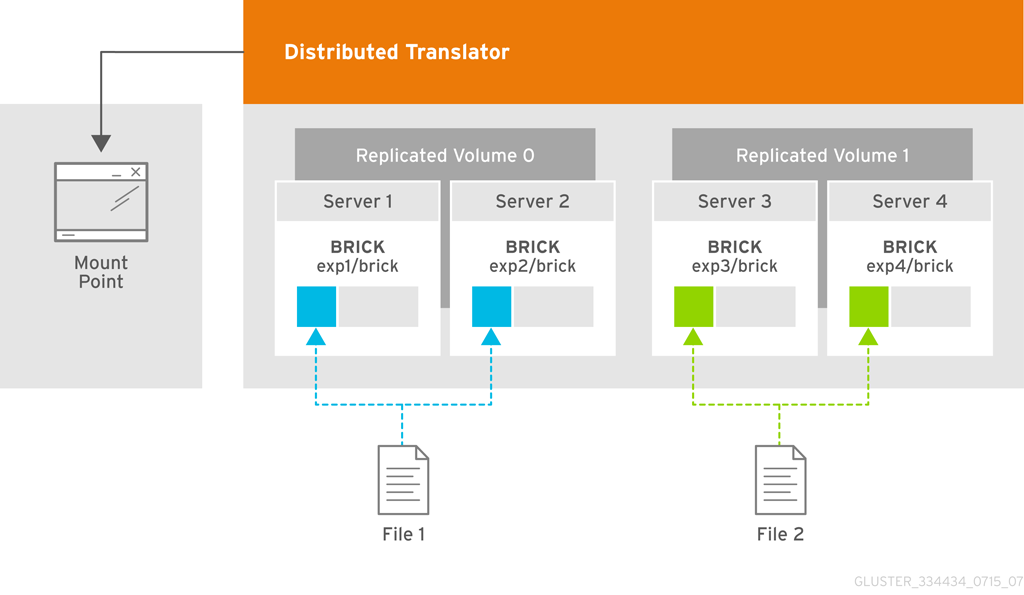-
Language:
English
-
Language:
English
Red Hat Training
A Red Hat training course is available for Red Hat Gluster Storage
5.7. Creating Distributed Replicated Volumes
Important
Creating distributed-replicated volume with replica count greater than 3 is under technology preview. Technology Preview features are not fully supported under Red Hat subscription level agreements (SLAs), may not be functionally complete, and are not intended for production use. However, these features provide early access to upcoming product innovations, enabling customers to test functionality and provide feedback during the development process. As Red Hat considers making future iterations of Technology Preview features generally available, we will provide commercially reasonable efforts to resolve any reported issues that customers experience when using these features.
Use distributed replicated volumes in environments where the requirement to scale storage, and high-reliability is critical. Distributed replicated volumes also offer improved read performance in most environments.
Note
The number of bricks must be a multiple of the replica count for a distributed replicated volume. Also, the order in which bricks are specified has a great effect on data protection. Each replica_count consecutive bricks in the list you give will form a replica set, with all replica sets combined into a distribute set. To ensure that replica-set members are not placed on the same node, list the first brick on every server, then the second brick on every server in the same order, and so on.
Prerequisites
- A trusted storage pool has been created, as described in Section 4.1, “Adding Servers to the Trusted Storage Pool”.
- Understand how to start and stop volumes, as described in Section 5.11, “Starting Volumes”.
5.7.1. Creating Two-way Distributed Replicated Volumes
Warning
Support for two-way replication is planned for deprecation and removal in future versions of Red Hat Gluster Storage. This will affect both replicated and distributed-replicated volumes.
Support is being removed because two-way replication does not provide adequate protection from split-brain conditions. While a dummy node can be used as an interim solution for this problem, Red Hat recommends that all volumes that currently use two-way replication are migrated to use either arbitrated replication or three-way replication.
Instructions for migrating a two-way replicated volume to an arbitrated replicated volume are available in Section 5.8.5, “Converting to an arbitrated volume”.
Information about three-way replication is available in Section 5.6.2, “Creating Three-way Replicated Volumes” and Section 5.7.2, “Creating Three-way Distributed Replicated Volumes”.
Two-way distributed replicated volumes distribute and create two copies of files across the bricks in a volume. The number of bricks must be multiple of the replica count for a replicated volume. To protect against server and disk failures, the bricks of the volume should be from different servers.

Figure 5.5. Illustration of a Two-way Distributed Replicated Volume
Creating two-way distributed replicated volumes
- Run the
gluster volume createcommand to create the distributed replicated volume.The syntax is# gluster volume create NEW-VOLNAME [replica COUNT] [transport tcp | rdma | tcp,rdma] NEW-BRICK...The default value for transport istcp. Other options can be passed such asauth.alloworauth.reject. See Section 11.1, “Configuring Volume Options” for a full list of parameters.Example 5.6. Four Node Distributed Replicated Volume with a Two-way Replication
The order in which bricks are specified determines how they are replicated with each other. For example, the first two bricks specified replicate each other where 2 is the replica count.# gluster volume create test-volume replica 2 transport tcp server1:/rhgs/brick1 server2:/rhgs/brick1 server3:/rhgs/brick1 server4:/rhgs/brick1 Creation of test-volume has been successful Please start the volume to access data.
Example 5.7. Six Node Distributed Replicated Volume with a Two-way Replication
# gluster volume create test-volume replica 2 transport tcp server1:/rhgs/brick1 server2:/rhgs/brick1 server3:/rhgs/brick1 server4:/rhgs/brick1 server5:/rhgs/brick1 server6:/rhgs/brick1 Creation of test-volume has been successful Please start the volume to access data.
- Run
# gluster volume start VOLNAMEto start the volume.# gluster volume start test-volume Starting test-volume has been successful
- Run
gluster volume infocommand to optionally display the volume information.
Important
You must ensure to set server-side quorum and client-side quorum on the distributed-replicated volumes to prevent split-brain scenarios. For more information on setting quorums, see Section 11.13.1, “Preventing Split-brain”
5.7.2. Creating Three-way Distributed Replicated Volumes
Three-way distributed replicated volume distributes and creates three copies of files across multiple bricks in the volume. The number of bricks must be equal to the replica count for a replicated volume. To protect against server and disk failures, it is recommended that the bricks of the volume are from different servers.
Synchronous three-way distributed replication is now fully supported in Red Hat Gluster Storage. It is recommended that three-way distributed replicated volumes use JBOD, but use of hardware RAID with three-way distributed replicated volumes is also supported.

Figure 5.6. Illustration of a Three-way Distributed Replicated Volume
Creating three-way distributed replicated volumes
- Run the
gluster volume createcommand to create the distributed replicated volume.The syntax is# gluster volume create NEW-VOLNAME [replica COUNT] [transport tcp | rdma | tcp,rdma] NEW-BRICK...The default value for transport istcp. Other options can be passed such asauth.alloworauth.reject. See Section 11.1, “Configuring Volume Options” for a full list of parameters.Example 5.8. Six Node Distributed Replicated Volume with a Three-way Replication
The order in which bricks are specified determines how bricks are replicated with each other. For example, first 3 bricks, where 3 is the replica count forms a replicate set.# gluster volume create test-volume replica 3 transport tcp server1:/rhgs/brick1 server2:/rhgs/brick1 server3:/rhgs/brick1 server4:/rhgs/brick1 server5:/rhgs/brick1 server6:/rhgs/brick1 Creation of test-volume has been successful Please start the volume to access data.
- Run
# gluster volume start VOLNAMEto start the volume.# gluster volume start test-volume Starting test-volume has been successful
- Run
gluster volume infocommand to optionally display the volume information.
Important
By default, the client-side quorum is enabled on three-way distributed replicated volumes. You must also set server-side quorum on the distributed-replicated volumes to prevent split-brain scenarios. For more information on setting quorums, see Section 11.13.1, “Preventing Split-brain”.

